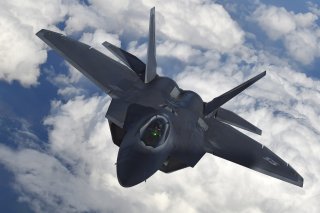‘Not a Simple Design’: The Latest on the Air Force’s Sixth-Generation Fighter
The sixth-generation fighter will proceed on a much slower timeline but will add real capabilities, U.S. Air Force Secretary Frank Kendall explained.
The United States Air Force’s sixth-generation aircraft, the Next Generation Air Dominance program (NGAD), will not be the kind of aircraft that can be steadily upgraded and tweaked every five years or so, Air Force Secretary Frank Kendall explained.
Speaking at the Air & Space Leaders in Action conference, Secretary Kendall admitted that while the early prototyping phase of the NGAD program had gone ahead rather quickly for a program of high ambitions, the further development of the NGAD platform will proceed on a much slower timeline.
“The NGAD that we’re working on now… is going to take longer. It’s a more complicated operation to have a manned aircraft” that will replace the F-22 stealth fighter Secretary Kendall explained, adding that it’s “not a simple design.”
The U.S. Air Force’s previous acquisition chief, Will Roper, had an ambitious vision for the Next Generation Air Dominance program in which small batches of 100 airframes were incrementally improved every five years or so. While Mr. Roper’s proposal could have given the U.S. Air Force new and cutting-edge aircraft quite frequently, Secretary Kendall explained the strategy might not be feasible.
“I have a lot of respect for Will Roper,” he said. “I’ve worked with him a lot, I think he has some really interesting ideas… I think you have to be careful about where you apply those ideas.”
Secretary Kendall explained that building a sixth-generation stealth aircraft is an intensely difficult engineering challenge and requires a painstaking and sometimes slow building process. The NGAD program is a “different animal entirely” from programs like the F-35 or F-22, both of which were expensive programs.
Part of the challenge is that the NGAD program is more significant than just a single platform: it is a family of systems in which up to five unmanned vehicles are to be commanded by the piloted NGAD aircraft.
The NGAD program will have “a suite of sensors; there’s a suite of weapons; there’s connectivity between them; there’s connectivity to the weapons; there’s offboard support that will provide targeting and situational awareness information to that operator who’s trying to control this formation,” Secretary Kendall explained.
“That operator will need a lot of… automated help to do his job effectively, but I think it’s going to be a very powerful concept,” he emphasized.
“You have an interesting virtue with that kind of formation in that you’re willing to put at high risk some elements of the formation because you don’t have people in them,” Secretary Kendall said. “And that opens up a suite of tactics that, today, would be unthinkable.”
Though the program is still in development, Secretary Kendall emphasized that he wants to get the Next Generation Air Dominance Program to pilots as quickly as possible.
“I’m not doing this as an experiment. I’m doing it as a real program. We’ve done an awful lot of experimentation, prototyping, and virtual planes and so on, over the last few years… I’m all about real capability. I’m all about putting meaningful capability in the hands of warfighters as quickly I can.”
Caleb Larson is a multimedia journalist and defense writer with the National Interest. A graduate of UCLA, he also holds a Master of Public Policy and lives in Berlin. He covers the intersection of conflict, security, and technology, focusing on American foreign policy, European security, and German society for both print and radio. Follow him on Twitter @calebmlarson.
Image: Reuters.

